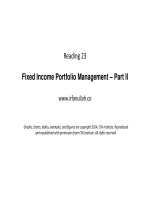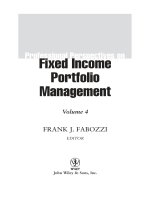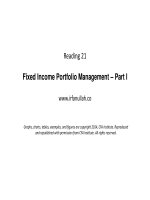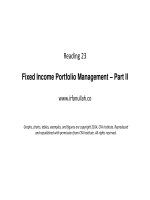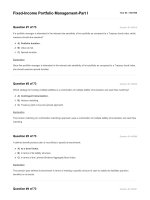Q a schweser self test 07 fixed income portfolio management answers
Bạn đang xem bản rút gọn của tài liệu. Xem và tải ngay bản đầy đủ của tài liệu tại đây (149.64 KB, 2 trang )
Question #1 of 6
A) total return analysis.
Explanation
Worthington is forecasting a change in two variables: interest rates and spreads. Total return
analysis will allow specifying both variables and how they change. The other two approaches
focus only on spread change and are less suitable in this case. Note that the forecast would
suggest both shortening portfolio duration and reducing spread duration, as both rates and
spreads are expected to increase.
Question #2 of 6
C) Buy interest rate caps.
Explanation
The expectation is for interest rates to rise. In this environment, bond prices, bond futures, and
call options on bond contracts will all fall in value, buying them is incorrect. Caps will become
more valuable as the cap owner will receive when rates rise above the strike rate. The caps
(options on interest rate) become more valuable as the underlying (rates) rise.
Question #3 of 6
B) $4.28
Buy futures contracts
Explanation
Bond A's dollar duration for a 100-basis-point move in rates is: (4.5)(0.01)($95) = $4.28. To
increase the dollar duration, Sumner should buy futures contracts.
Question #4 of 6
A) does not consider the magnitude of losses.
Explanation
Shortfall risk does not consider the impact of outliers so the magnitude (dollar amount) of the
shortfall below the target return is ignored. Semivarianceis difficult to compute for a large bond
portfolio and since it is estimated with only half the distribution, it is estimated with less
accuracy. Standard deviation is a historically calculated risk measure that may not represent the
risk that will be observed in the future.
Question #5 of 6
B) Correct
Incorrect
Explanation
A barbell strategy exploits a flattening of the yield curve. The barbell invests in both a short-term
and a long-term bond. When the yield curve flattens, characterized in this case by long-term
rates falling while short-term rates rise, the decrease in the long-term yield results in a stronger
price increase than the decrease in the short-term bond's price because the long-term bond has
a longer duration. With a normal upward-sloping yield curve, a flattening could also occur with
long-term rates falling more than short- term rates. However, the barbell and bullet strategies will
not perform the same way in immunizing a single-period liability. Think of it in terms of the
lowest-risk way to immunize the single-period liability is with a zero coupon bond. With only one
cash flow this is the ultimate bullet and has no immunization risk. The more the portfolio shifts
towards a barbell structure the more immunization risk is created. The barbell approach can be
used if the duration of the liability is matched, but it is more risky than a bullet structure for this
objective.
Question #6 of 6
A) one is correct.
Explanation
Wortek is correct. Quality spread analysis uses the spread on high-quality and low- quality bonds
to identify the bonds that have a yield higher than that justified by its credit risk. Benson is
incorrect. Percentage yield spread analysis, which divides a bond's yield by a government bond's
yield so that mispriced bonds may be identified, is of little use because there are many additional
factors that affect a bond's yield.
